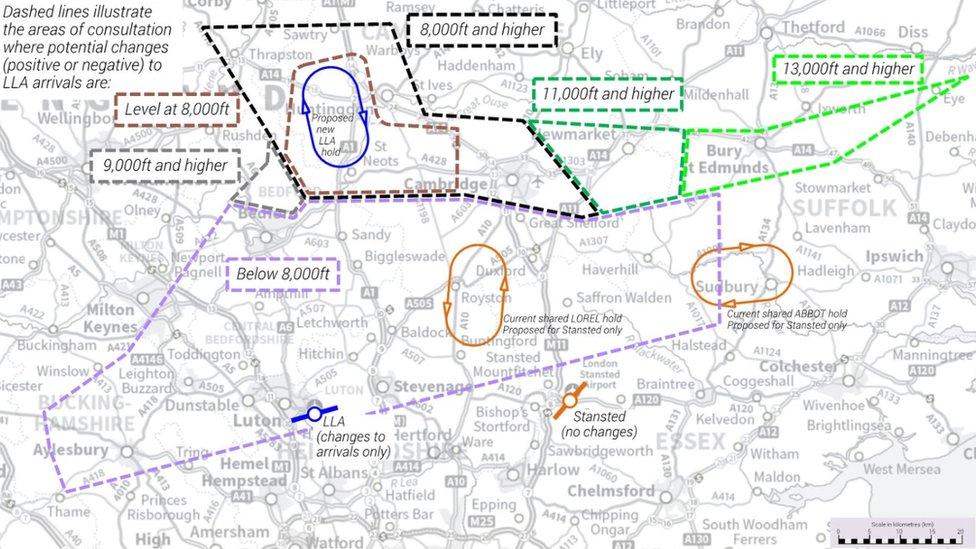Local campaign groups oppose Luton Airport expansion plans and flight path changes, due to noise
Two campaign groups dedicated to reducing noise from Luton Airport have hit out at its latest plans for expansion. LADACAN (Luton And District Association for the Control of Aircraft Noise) and STAQS (St Albans Quieter Skies) have rejected the airport’s plans as “both unjustified and unmerited” in a series of responses to the consultation (ends 5th Feb 2021). LADACAN said: “Airport growth going forward has to be more responsibly managed than in the past. The industry is innately carbon-inefficient at present due to outdated airspace design, which forces planes into holding stacks and causes Luton departures to be held low sometimes for 15-20 miles. This is very wasteful of fuel and causes far more widespread noise than necessary.” They also say the latest aircraft introduced into the Luton fleet, the Airbus A321-neo was meant to be a bit less noisy than the A321, but it is not. STAQS said claims of a 2dB noise benefit from the A321-neo in the Airport’s noise reduction strategy are ‘wishful thinking’. “Luton Council needs to send Luton Airport a really clear signal that noise conditions are there for a purpose, which might focus some effort on growth balanced by mitigation, as the government requires.”
.
Tweet
Anti-noise campaign groups hit out at Luton Airport expansion plans
Two campaign groups dedicated to reducing noise from Luton Airport have hit out at its latest plans for expansion.
By Stewart Carr (Luton Today)
16th November 2020
The consultation documents, including maps, are at https://consultations.airspacechange.co.uk/london-luton-airport/ad6_luton_arrivals/
The consultation will run from Monday 19th October 2020 – Friday 5th February 2021.
The main document is at https://consultations.airspacechange.co.uk/london-luton-airport/ad6_luton_arrivals/user_uploads/lla-arrivals-consultation-document-screenview-1-3.0.pdf
LADACAN (Luton And District Association for the Control of Aircraft Noise) and STAQS (St Albans Quieter Skies) have rejected the plans as “both unjustified and unmerited” in a series of responses to the pre-consultation.
Andrew Lambourne, spokesman for LADACAN, said: “Airport growth going forward has to be more responsibly managed than in the past.
“The industry is innately carbon-inefficient at present due to outdated airspace design, which forces planes into holding stacks and causes Luton departures to be held low sometimes for 15-20 miles.
“This is very wasteful of fuel and causes far more widespread noise than necessary.
“Equally the latest aircraft introduced into the Luton fleet have proved not to be slightly quieter as expected, and that issue needs to be resolved quickly.”
Luton Airport has signalled it may apply for planning permission to alternate four of the planning conditions laid down by Luton Borough Council in 2013. But its expansion plans have repeatedly faced firm opposition from neighbouring Hertfordshire County Council.
John Hale, on behalf of STAQS, added: “The Airport has to meet legally agreed noise reduction targets, and should undo its recent mistake of allowing airlines like Wizz to introduce even larger and noisier planes like the Airbus A321-neo.
“While claimed to be ‘quieter-engined’, it has proved to be noisier than its A321 predecessor when flown from Luton, making claims of a 2dB noise benefit in the Airport’s noise reduction strategy ‘wishful thinking’. Luton Council needs to send Luton Airport a really clear signal that noise conditions are there for a purpose, which might focus some effort on growth balanced by mitigation, as the government requires.”
In response to the above criticisms, a London Luton Airport (LLA) spokesman said: “While current circumstances mean we are unlikely to see this number of passengers for several years, it’s essential we take steps now to safeguard the airport, jobs and support the region’s post COVID recovery. The changes we are proposing will not result in any visible difference to the airport, and will work entirely within existing infrastructure.
“Our consultation has provided an opportunity for the local community, passengers and business partners to feedback on our proposals, ahead of a formal application, which will follow the relevant planning process.
“An environmental impact assessment is also being carried out to identify any potential effects and possible mitigations to ensure we can deliver a plan for the future of the airport and its continued contribution to the local community”.
.
.
See earlier:
Public consultation to open for new arrival routes into London Luton Airport
19.11.2020 (International Airports Review)
The consultation will allow local residents and communities to shape the outcome of the proposed plans to separate Luton and Stansted’s arrival routes and holds.
A public consultation to help to determine new arrival routes for flights into London Luton Airport (LLA) will open on 19 October 2020 and run to 5 February 2021, offering residents and communities in the surrounding areas the chance to have their say and shape the outcome.
LLA currently shares arrival routes and holds with London Stansted Airport (STN), a unique and unsustainable situation for airports of this size in the UK. Any delay at one airport, either in the air or on the ground, impacts the other and can cause additional delay, noise and carbon emissions. The proposed changes will separate routes further out and higher up and create a new hold for Luton arrivals, to ensure that operations for Luton and Stansted don’t impact each other.
The joint consultation – co-sponsored by LLA and UK air traffic control provider, NATS – is looking at two options to simplify the arrival routes for flights into the country’s fifth busiest airport and segregate them from Stansted’s, ensuring optimum safety.
During this webinar, AOE discussed how the travel industry has been decimated by COVID-19. Using learnings and case studies from experiences in designing, building and implementing similar transformational digital and transactional platforms for Frankfurt, Auckland and Heathrow, AOE’s CEO, Kian Gould showed that a paradigm change is already possible and indeed, no longer an option but an imperative.
The first option uses the latest air navigation technology (Performance Based Navigation – PBN) at higher altitudes (approximately 8,000ft and above) to separate Luton Airport’s arrivals from Stansted’s, with air traffic controllers tactically descending and directing aircraft from approximately 8,000ft to land. The second, preferred option, is the same, but extends the availability of PBN to final approach, which allows a predictable, more equitable distribution of flights for communities beneath.
The proposals being put forward by LLA and NATS affect areas not only in the immediate vicinity of Luton Airport, but also wider areas across Bedfordshire, Buckinghamshire, Cambridgeshire, Essex, Hertfordshire and Suffolk. An online postcode tool allows anyone living or working in these areas to see what the changes may mean for them.
To comply with COVID-19 health and safety restrictions, representatives from LLA and NATS will host a number of webinars and virtual meetings throughout the consultation period to present the details of the proposal to local communities, airspace users, businesses and MPs. These will replace traditional ‘town hall’ meetings and drop-in events and provide a platform for participants to put questions forth to subject matter experts. A virtual exhibition will offer everyone access to all of the information they need to make an informed decision and provide feedback that will help to determine the final proposal.
Neil Thompson, Operations Director at London Luton Airport, said: “Any airspace change can have impacts for a wide variety of people. Local communities may be affected by noise, airlines will see a change to the routes that they fly and local airspace users may see changes too. That’s why, over the last 18 months, we’ve been working hard with NATS, local community representatives, airlines and others to help to develop the final proposals in this consultation. It’s now really important that we hear from the wider community during the 15-week consultation.”
Head of Swanwick Development at NATS, Lee Boulton, said: “The number of flights into London Luton Airport has increased significantly in recent years, and our controllers have had to delay aircraft and manually manage each flight to ensure safety. This proposal is all about ensuring safety and the consultation is a great opportunity for people to give us their feedback and help shape the proposed options, so that the airspace around the airport operates more effectively into the future.”
.
London Luton Airport: Consultation into moving holding area from Herts to Cambs

A public consultation to help determine new arrival routes for flights into London Luton Airport has started. The airport currently shares arrival routes and airborne holding areas with Stansted in Essex, with a key position above Royston in Hertfordshire. The proposed new holding area would be above the A1 between Alconbury and St Neots in Cambridgeshire. Luton and Stansted currently use zones above Royston, and above Sudbury in Suffolk, at about 8,000ft. The proposed changes would create a new holding area for Luton arrivals, to ensure that operations for Luton and Stansted do not have an impact on each other. For more information check out the consultation website. This consultation runs until 5 February 2021.
.
.
.
